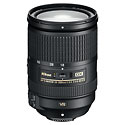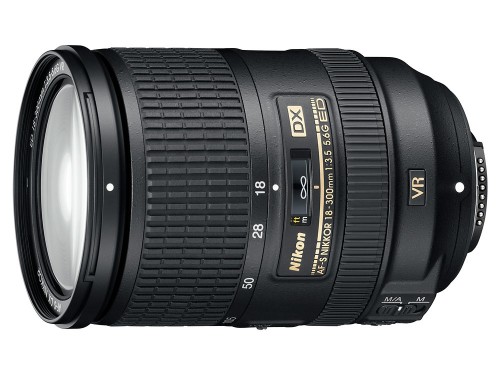 Last night, Nikon announced a crazy new 16.7x DX format (APS-C) superzoom lens, the AF-S DX Nikkor 18-300mm f/3.5-5.6G ED VR. This really ups the ante over Nikon’s 18-200mm VR and other 18-200mm image-stabilized zoom lenses. And based on the $1000 price tag, the new Nikkor 18-300mm superzoom isn’t just another mushy consumer piece of junk, either.
Last night, Nikon announced a crazy new 16.7x DX format (APS-C) superzoom lens, the AF-S DX Nikkor 18-300mm f/3.5-5.6G ED VR. This really ups the ante over Nikon’s 18-200mm VR and other 18-200mm image-stabilized zoom lenses. And based on the $1000 price tag, the new Nikkor 18-300mm superzoom isn’t just another mushy consumer piece of junk, either.
Nikon set the standard for consumer superzoom lenses about 5 years ago when they introduced the AF-S DX Nikkor 18-200mm f/3.5-5.6G ED VR zoom – that’s a 27-300mm equivalent in the 35mm / full-frame format. Non-Nikon owners, especially outdoor and travel photographers, coveted the Nikon 18-200mm VR zoom for its compact versatility and now the 18-200mm image-stabilized zoom lens has become a standard option for APS-C sensor cameras of all makes. I’m a huge fan of the 18-200mm zoom range and it’s my most-used lens on an APS-C digital SLR. I especially love the 18-200mm for mountain biking, backpacking and skiing where size and weight really matter. However, the new Nikon 18-300mm VR zoom lens caught me off guard. It never occurred to me that Nikon would push the superzoom concept so far. The 18-300mm focal length is equivalent to an incredible 27-450mm zoom on a 35mm / full-frame camera. Nikon’s Vibration Reduction II (VR) optical image stabilization is critical with that kind of telephoto range but it’s supposed to correct for up to 4 stops so unless the light is bad it should keep things steady and sharp.
Some other nice 18-300mm VR zoom lens details are a 1.48 foot (0.45m) minimum focus distance at 300mm, making it a nice close-up lens; a zoom lock switch to keep the lens from zooming out when you’re walking around with the camera on a strap; and a rounded 9-blade aperture ring for nice smooth out-of-focus image quality (bokeh). According to the specs page on the Nikon USA Web site, the 18-300mm also comes with a lens hood and a carrying pouch.
I loved the original Nikon 18-200mm VR zoom lens. That’s been an excellent all-purpose zoom range for me and I recommend the Nikon and other 18-200mm image-stabilized zooms to more people than any other lens. It’s great for first-time digital SLR owners and if you’re a pro, it’s a great event, travel or backpacking lens. But sometimes (a lot of times, actually), I still want more. The new Nikkor 18-300mm VR is about an inch longer and over half a pound heavier (270g) than the 18-200mm VR, so there is a cost to the expanded zoom range. But if you’re a travel or outdoor photographer that always wishes you had a longer lens, then it’s probably worth packing the extra size and weight. Of course, we’ll have to wait and see how the image quality is. I wouldn’t expect top shelf quality but the 18-200mm VR is much better than a kit lens and Nikon used three ED elements and three aspherical elements in the 18-300mm so you know they mean business. And there’s also that $1000 price tag. For that kind of money Nikon you’d better be getting good glass.
Want one? Nikon’s new AF-S DX Nikkor 18-300mm f/3.5-5.6G ED VR zoom lens will be available at the end of the month (June, 2012) at a suggested retail price of US $999.95. I’m betting this one is gonna be a hot seller.
Nikon AF-S DX Nikkor 18-300mm VR Lens Press Release >>
Related Content:
All Nikon User Reviews
All Lens User Reviews
Nikon Cameras Forum
Digital SLR Forum
All Nikon News & Articles
Nikon Web Site



Looked at the 80-400 recently both the Tokina without & Nikon with the VR. You carry a lot of weight but gives you lots of room. Found both versions heavy and slow. Feel more comfortable using them with tripod than hand-held shots.
A lens like 18-300 may be a “1 size fits all” but personally prefer to split the range in half. Even on vacation wouldn’t mind carrying 2 separate lenses 18-70 & 70-300. Found very few occasions where you need to zoom up from 28 to 300 quickly. When it comes to family photos, tend to go with shorter lens so don’t need to carry this kind of weight.
Thanks for the comment, Hoasjoe. Two lenses is almost always the better strategy when image quality is your top priority. However, I do a lot of mountain bike and ski photography where it’s a reasonable compromise to trade a bit of image quality so you can carry only one lens. It’s not always the right thing to do but it’s nice to have that option – as long as the image quality isn’t compromised too much. I’ve found the Nikon and Canon 18-200mm lenses are way better than I expected and I’m hoping the same is true of the 18-300mm VR. That said, it won’t be right for everyone.